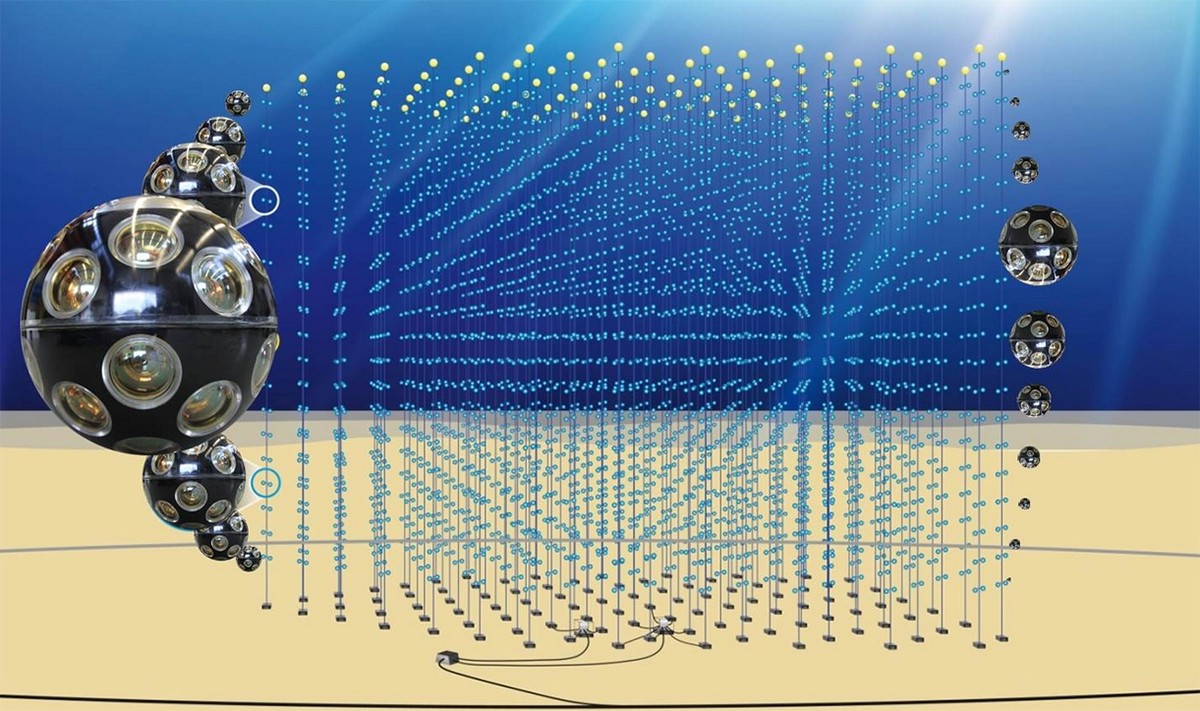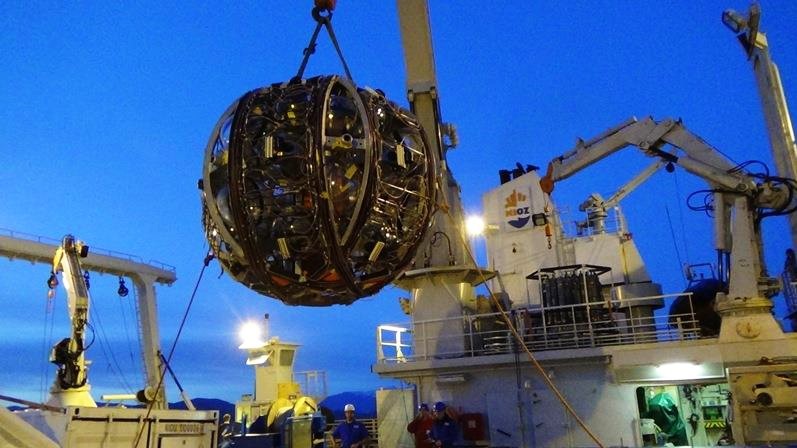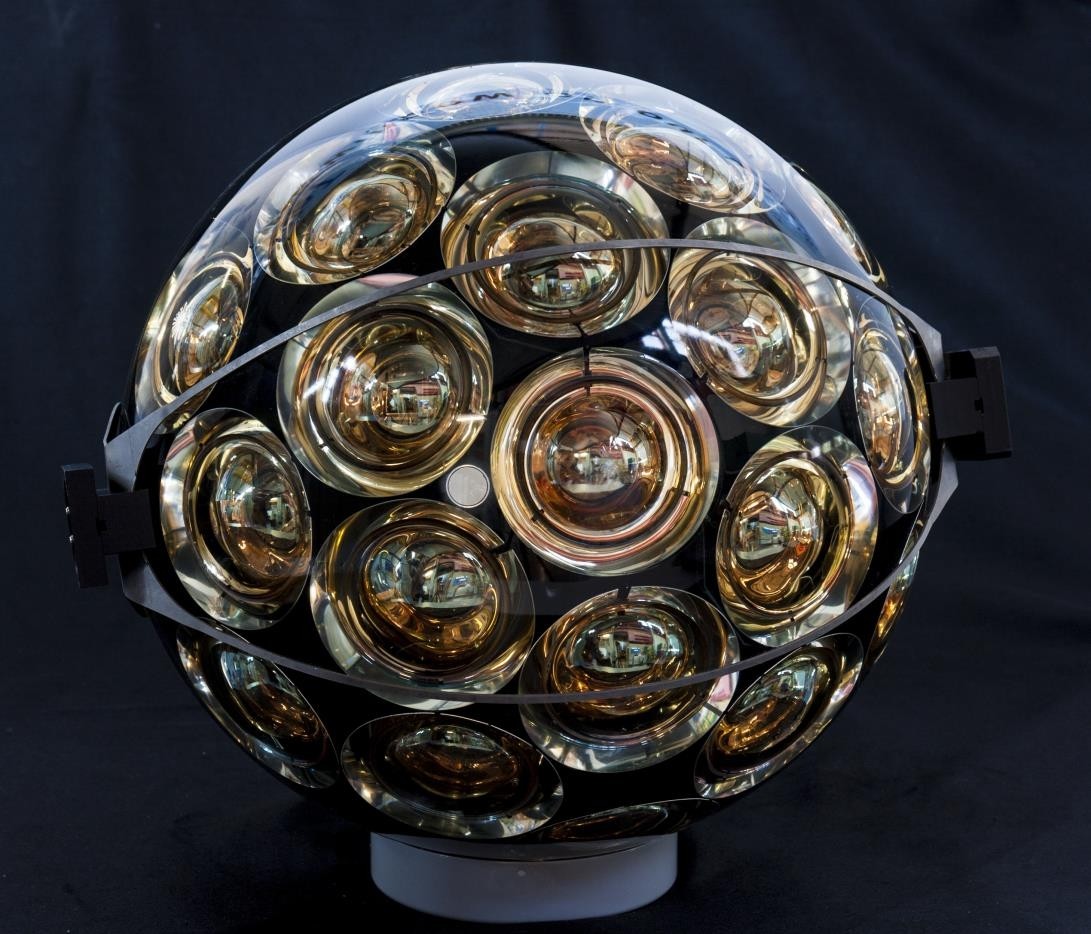Miljoeneninvestering in neutrinotelescoop KM3NeT

Artist’s impression of the KM3NeT neutrino detection array. The infrastructure comprises two arrays, ARCA and ORCA that will be placed on the bottom of the Mediterranean Sea at a depth of 3.5 km and 2.5 km, respectively. Both ARCA and ORCA consist of vertical strings, each of which is comprised of 18 optical modules. Each optical module consists of a pressure resistant glass sphere housing 31 small photo-multiplier tubes (yellowish disk in the picture) that detect the patterns of Cherenkov light created by the interactions of neutrinos (earlier detectors used one large sensor per sphere).
Deze toekenning geeft een forse impuls aan het voltooien van de neutrinotelescoop KM3NeT. KM3NeT wordt gebouwd om onderzoek te doen naar de fundamentele eigenschappen van neutrino’s en naar astrofysische bronnen van kosmische neutrino’s, en faciliteert zeeonderzoek en onderzoek naar zeezoogdieren. De telescoop komt diep in de Middellandse Zee; de geplande locaties zijn bij Toulon (Frankrijk) en Sicilië (Italië).
Nederlandse bijdrage
Nederland speelt vanaf het begin een belangrijke rol in dit onderzoek. De indieners van Nikhef en van NIOZ, TNO, KVI-CART, de Universiteit van Amsterdam, Universiteit Leiden, Vrije Universiteit en Radboud Universiteit zijn trots op de honorering.
"De Nederlandse bijdragen zijn essentieel voor het welslagen van dit internationale project", zegt Stan Bentvelsen, directeur Nikhef. "Samen met NIOZ, TNO en KVI-CART heeft Nikhef vrijwel alle onderdelen van de detector ontworpen. We geven leiding aan de bouw van de detector en spelen een cruciale rol bij het wetenschappelijk onderzoek. Met deze geweldige toekenning kunnen we dat blijven doen. Dit is een project waar we met recht trots op zijn."
Ook Els Koffeman, technische coördinator van KM3NeT en verbonden aan Nikhef, is enthousiast: "Fantastisch! Met deze middelen kunnen we onze plannen waarmaken. We gaan een groot watervolume in de diepte van de Middellandse Zee voorzien van lichtgevoelige detectoren. De eerste detectie van neutrino’s met deze nieuwe onderzoeksfaciliteit wordt verwacht in 2020."
Multidisciplinaire onderzoeksinfrastructuur
"Deze toekenning stelt ons in staat om KM3NeT uit te bouwen tot een multidisciplinaire onderzoeksinfrastructuur van ongekende omvang", aldus Paul de Jong, programmaleider van de KM3NeT-groep van Nikhef. "KM3NeT biedt ons de kans op wetenschappelijke doorbraken op het gebied van neutrinofysica, neutrino-astronomie, zeeonderzoek en onderzoek naar zeezoogdieren."
Nikhef-onderzoeker Aart Heijboer, deputy spokesperson van KM3NeT, licht de kansen voor neutrinofysica en neutrino-astronomie toe: "Neutrino's zijn spookachtige elementaire deeltjes die geproduceerd worden in spectaculaire astrofysische objecten, zoals de zwarte gaten die zich bevinden het centrum van sterrenstelsels. Met KM3NeT gaan we die neutrino's detecteren en vaststellen waar ze precies vandaan komen. Daarmee creëren we een heel nieuwe manier om het heelal te bestuderen. Bovendien gaan we met KM3NeT de fundamentele eigenschappen van de neutrino's zelf ontrafelen, wat van belang is voor zowel deeltjesfysica als kosmologie."
KM3NeT faciliteert bovendien zeeonderzoek en onderzoek naar zeezoogdieren, door naast de lichtgevoelige detectoren ook temperatuursensoren en hydrofoontechnologie te installeren.
Diepzeetransport
Hans van Haren, zeeonderzoeker bij NIOZ, is blij met deze kans: "KM3NeT biedt de gelegenheid om een uniek 3D-netwerk van 3000 gevoelige temperatuursensoren te bouwen in een kubieke hectometer diepzee water. Daarmee kunnen driedimensionale processen van brekende interne golven en turbulente menging in detail worden bestudeerd. Dit zal een grote stap vooruit betekenen voor studies van diepzeetransport van materiaal. Tot nog toe hadden we daar alleen metingen in een richting van."

Ernst-Jan Buis is als onderzoeker van TNO betrokken bij KM3NeT: "Dit project stelt ons in staat extreem gevoelige hydrofoontechnologie te ontwikkelen, waarmee we uiteindelijk niet alleen zeezoogdieren kunnen bestuderen, maar ook het geluid kunnen detecteren dat een neutrino-interactie in water veroorzaakt. Daarnaast vraagt het bouwen van een sensornetwork in een extreme omgeving als de diepzee buitengewone ingenieurscapaciteiten. TNO kan met z'n jarenlange ervaring op het gebied van ruimtevaart-engineering een goede bijdrage leveren aan de constructie van KM3NeT."
KM3NeT
KM3NeT is een internationale samenwerking van 51 instituten en universiteiten uit 15 landen. De neutrinotelescoop KM3NeT is de opvolger van de kleinere neutrinotelescoop ANTARES. Op dit moment wordt intensief gewerkt aan het bouwen van de detector-onderdelen. Uiteindelijk zal KM3NeT uit meer dan 300 lijnen bestaan, met aan elke lijn 18 lichtgevoelige detectoren, zogeheten Digital Optical Modules (DOM’s). Daarnaast zal KM3NeT een groot netwerk van temperatuursensoren en hydrofoons bevatten. Het Nederlands onderzoeksschip Pelagia wordt ingezet om de telescoop in zee te zetten. Over vijf jaar zijn naar verwachting zowel de locatie bij Toulon als bij Sicilië operationeel.
Neutrino telescope KM3NeT receives a 12.7 Million Euro NWO grant
The Dutch contribution to the neutrino telescope KM3NeT has received an investment grant of 12.7 Million Euro. KM3NeT is one of the ten top research facilities in NWO’s "National Roadmap for Large-scale Research Infrastructure". Today, Minister Van Engelshoven, of Education, Culture and Science, issued the Roadmap certificates. The construction or renewal of these facilities has been given the highest priority.

Artist’s impression of the KM3NeT neutrino detection array. The infrastructure comprises two arrays, ARCA and ORCA that will be placed on the bottom of the Mediterranean Sea at a depth of 3.5 km and 2.5 km, respectively. Both ARCA and ORCA consist of vertical strings, each of which is comprised of 18 optical modules. Each optical module consists of a pressure resistant glass sphere housing 31 small photo-multiplier tubes (yellowish disk in the picture) that detect the patterns of Cherenkov light created by the interactions of neutrinos (earlier detectors used one large sensor per sphere).
This grant will give the completion of the neutrino telescope KM3NeT a big boost. KM3NeT is going to perform research into the fundamental properties of neutrinos and the astrophysical sources of cosmic neutrinos, and it will facilitate sea research and marine biology. The neutrino telescope will be placed deep in the Mediterranean Sea, the planned installation sites are off the shore near Toulon (France) and Sicily (Italy).
Since the start, the Netherlands has played an important role in this research. The applicants from Nikhef, together with NIOZ, TNO, KVI-CART, the University of Amsterdam, University Leiden, VU University and Radboud University, are very proud of the approval of this grant.
"The Dutch contributions are essential for the success of this international project", says Stan Bentvelsen, Nikhef director. "Together with NIOZ, TNO and KVI-CART, Nikhef has designed nearly every component of the detector. We lead the construction of the detector, and play a crucial role in the research. With this fantastic grant, we can keep on doing this. This is a project we are very proud of."
Els Koffeman, technical coordinator of KM3NeT and Nikhef researcher, is alsoenthusiastic: “Excellent! With this support we can make our plans a reality. We will fill a deep, large volume of water in the Mediterranean Sea with light sensitive detection units. We expect to detect the first neutrinos in 2020!”
"This funding will allow us to make KM3NeT a truly multi-disciplinary infrastructure
of an unprecedented size”, says Paul de Jong, programme leader of the KM3NeT group at Nikhef. “KM3NeT will facilitate scientific breakthroughs in neutrino physics, neutrino astronomy, sea research and marine biology."
Nikhef researcher Aart Heijboer, deputy spokesperson of KM3NeT, illustrates the opportunities for neutrino physics and neutrino astronomy: "Neutrinos are ghostly elementary particles that are produced in some of the most spectacular astrophysical regions, such as the centers of galaxies that house massive black holes. With KM3NeT, we will detect these neutrinos and pinpoint their sources, opening up a completely new way to study the Universe. Moreover, we can unravel the fundamental particle physics of neutrinos, which is important for understanding the evolution of the Universe."
KM3NeT furthermore facilitates sea research and marine biology through temperature sensors and hydrophones which will be installed alongside the light sensitive detector units.
Deep sea transport
Hans van Haren, sea researcher at NIOZ, appreciates these opportunities: "KM3NeT offers to build a unique 3D network of 3000 high-resolution temperature sensors in a cubic hectometer of deep-sea to study essentially three-dimensional phenomena of internal wave turbulent mixing. This will enable new studies on the transport of matter, which has thus far only been done with measurements in one direction."

The KM3NeT strings are deployed using a launcher vehicle, developed by NIOZ. The picture shows the launcher vehicle, equipped with a detection line, being loaded on the RV Pelagia. The launcher is lowered to the seabed. On release, the launcher rises to the surface, unfurling the detection string like an invested yoyo.
Ernst-Jan Buis is involved in the project as a TNO researcher: "This project enables us to develop extremely sensitive hydrophone technology which can be used not only to study marine biology, but also to detect acoustic signals from neutrino interactions in water. Furthermore, the construction of such a complex network of detectors under such extreme conditions as present in the deep-sea, asks for special engineering skills. TNO, with its long-standing experiences in space-engineering, can contribute greatly to the construction of KM3NeT."
KM3NeT is an international collaboration of 51 institutes and universities from 15 countries. The neutrino telescope KM3NeT is the successor of the smaller neutrino telescope ANTARES. At the moment, the construction of all detector components is well underway. The final KM3NeT neutrino telescope will consist of more than 300 strings, each with 18 light sensitive detector units, so-called Digital Optical Modules (DOMs). Beside this, KM3NeT will include a large network of temperature sensors and hydrophones. The Dutch research vessel Pelagia will be used to deploy the telescope in the sea. The sites in Toulon and Sicily are expected to be both fully deployed and operational in five years' time.

De KM3NeT optische module is een drukbestendige glazen bol met 31 fotosensoren die de zwakke lichtflitsen detecteren die het gevolg zijn van interacties van neutrino's in de afgrond van de Middellandse Zee. De volledige infrastructuur zal ongeveer 6000 van deze modules huisvesten. De optische module is een Nederlands ontwerp.
The KM3NeT optical module is a pressure resistant glass sphere housing 31 photosensors that will detect the faint flashes of light originating from interactions of neutrinos in the abyss of the Mediterranean. The full infrastructure will house about 6000 of these modules. The optical module is a Dutch design.